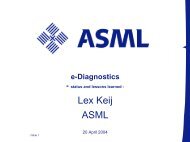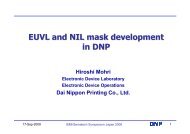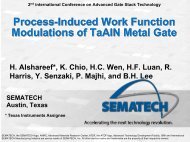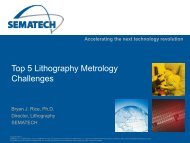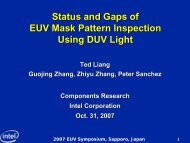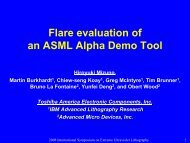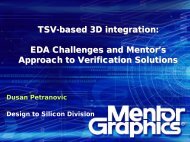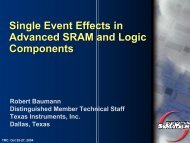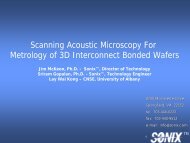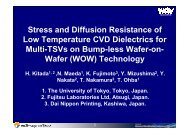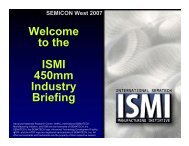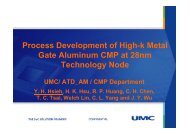You also want an ePaper? Increase the reach of your titles
YUMPU automatically turns print PDFs into web optimized ePapers that Google loves.
Installed defect inspection system2351ACT12EETKLA-Tencor 2351‣ Installed just next tothe Immersion cluster.EET (Engineering EvaluationTool, NA=0.85 immersion)Sept. 13, 2005 2nd International symposium on Immersion Lithography. Slide 4
Inspection settings of 2351Typical wafer resultsPoints of settings.<strong>Defect</strong> count14012010080604020‣ Increase SEM-visible defectcount.‣ Reduce SEM non-visibledefect count.Highest sensitivity at Nikonsetting.0ABCKLARec.NikonSEM-VisibleSEM non-visibleMode Image mode Illumination Pix size TDI gain ThresholdNikon Array Bright Field UV 0.16 4.5Auto20KLA-TencorrecommendationArray Edge contrast UV 0.2 3.6 Auto3Setting A Random Bright Field Visible ---- ---- ----Setting B Array Edge contrast UV ---- ---- ----Setting C Array Edge contrast Visible ---- --------Sept. 13, 2005 2nd International symposium on Immersion Lithography. Slide 5
<strong>Defect</strong>ivity in dry exposure, baseline0.14<strong>Defect</strong>ivity in dry exposureAverage.Dry baseline.60[/cm 2 ]<strong>Defect</strong> <strong>density</strong>0.120.10.080.060.040.020No.1 TArF-P6111TArF-P6111& TSP-3ANo.2No.1No.2Resist-A, TC-ASEM visible defect w/o dustResist B, TC-B50403020100<strong>Defect</strong> count(300mm wafer)Average defect <strong>density</strong> at dry exposure 0.11[/cm 2 ]Average defect count at dry exposure(300mm wafer)48Sept. 13, 2005 2nd International symposium on Immersion Lithography. Slide 6
Three immersion resist processes1. Solvent soluble topcoat2. Topcoat-less resist3. Developer soluble topcoatHow defectivity behave in these processes?Sept. 13, 2005 2nd International symposium on Immersion Lithography. Slide 7
Solvent-soluble topcoatSept. 13, 2005 2nd International symposium on Immersion Lithography. Slide 8
Solvent Soluble TC (TSP-3A), Dry & Wet[/cm 2 ]<strong>Defect</strong> <strong>density</strong>0.140.120.10.080.060.040.020DryTSP-3A. Dry & Wet.No.1 No.2 No.1 No.2WetSEM visible defect w/o dust.Dry baseline6050403020100<strong>Defect</strong> count (300mm wafer)No significantdifferencebetween dry & wetDry DryWet Wet<strong>Defect</strong> map150nm LSDry:S307, Wet:EETMaterials:AR-26, TArF-P6111, TSP-3ASept. 13, 2005 2nd International symposium on Immersion Lithography. Slide 9
Classification of TSP-3A defectivity[/cm 2 ]<strong>Defect</strong> <strong>density</strong>0.080.060.040.020Dry DryBridge(S,Round)Wet WetBridge(S,Sharp)Classification. TSP-3A, Dry & Wet.Bridge (S, Bridge BridgeProtrusion) (S,Other) (L,Round)Bridge(L,Other)Stain3026221713940(300mm wafer)<strong>Defect</strong> countNo immersion specific defect with TSP-3ASept. 13, 2005 2nd International symposium on Immersion Lithography. Slide 10
Topcoat-less resistSept. 13, 2005 2nd International symposium on Immersion Lithography. Slide 11
TArF-P6111, Dry & Wet[/cm 2 ]<strong>Defect</strong> <strong>density</strong>0.20.150.10.050TArF-P6111, Dry & WetDry baselineNo.1No.2No.1No.2DryWetSEM visible defect w/o dust100806040200(300mm wafer)<strong>Defect</strong>s are increasedin immersion.<strong>Defect</strong> countDry DryWet Wet150nm LSDry:S307, Wet:EETMaterials:AR-26, TArF-P6111Sept. 13, 2005 2nd International symposium on Immersion Lithography. Slide 12
Detailed classification of TArF-P6111[/cm 2 ]<strong>Defect</strong> <strong>density</strong>0.20.180.160.140.120.10.080.060.040.020Dry DryTArF-P6111, Dry & Wet.Wet WetBridge (S) Bridge (L) Stain Others SEM visibledefect w/odustDry baselineVisibledefect w/odust andBridge (S)86786960524334261790(300mm wafer)<strong>Defect</strong> count‣ Bridge small is increased in immersion.‣ If it is improved, defectivity goes down to the dry baseline.Sept. 13, 2005 2nd International symposium on Immersion Lithography. Slide 13
Developer-soluble topcoatSept. 13, 2005 2nd International symposium on Immersion Lithography. Slide 14
Various developer soluble topcoats (Wet)[/cm 2 ]<strong>Defect</strong> <strong>density</strong>0.70.60.50.40.30.20.1<strong>Defect</strong>ivity on developer soluble topcoats (wet)0Resist-A, TC-ANo.1Resist-B,TC-BNo.1No.2Resist-C,TC-CNo.1No.2SEM visible defect w/o dustResist-D,TC-DNo.1300250200150100500(300mm wafer)<strong>Defect</strong> countDry baseline‣ For every topcoat, defects are increasedin immersion exposure.Sept. 13, 2005 2nd International symposium on Immersion Lithography. Slide 15
Two types of immersion specific defects withdeveloper soluble topcoatCircular pitchnarrowingLinedeformation‣ <strong>Defect</strong> causes are discovered as topcoatdefect (next slide).Sept. 13, 2005 2nd International symposium on Immersion Lithography. Slide 16
How to determine the cause of defect?1. After PEB, reviewtopcoat defects2. Then develop the wafer3. Review the same positionSept. 13, 2005 2nd International symposium on Immersion Lithography. Slide 17
Blister of topcoat Circular pitch narrowingTopcoat defectPatterned defectPosition is shifted.Blister is unstable?Observed the same positionSept. 13, 2005 2nd International symposium on Immersion Lithography. Slide 18
Change of blister during SEM reviewZoomZoomTopcoat defectMechanism of circularpitch narrowingArF beamIces? Water spills outand frozen in vacuumduring SEM review?WaterBlister disappearedSame positionPatterned defectT.C.ResistDarkPitch narrowDarkSept. 13, 2005 2nd International symposium on Immersion Lithography. Slide 19
Particle Line deformationTopcoat defectPatterned defectObserved the same position‣ Particles cause line deformation.‣ Particles seem to be transparent to 193nm light. Fraction of topcoat?Sept. 13, 2005 2nd International symposium on Immersion Lithography. Slide 20
Promising developer soluble topcoat (1)[/cm 2 ]<strong>Defect</strong> <strong>density</strong>0.30.250.20.150.10.050Dry & Wet. Resist C, topcoat C.Dry baselineBridge (S) Bridge (L) Stain Others SEMvisibledefect w/odustSEMvisibledefect w/odust andstain129108866543220(300mm wafer)<strong>Defect</strong> count‣ Stain is the main part of immersion defects.‣ Stains are not killer defects (resist vendor’s comment).‣ If improved, defectivity goes down to the baseline.Sept. 13, 2005 2nd International symposium on Immersion Lithography. Slide 21
Promising developer soluble topcoat (2)[/cm 2 ]<strong>Defect</strong> <strong>density</strong>0.250.20.150.10.050Dry & Wet. Resist D, topcoat D.Bridge(S) Bridge(L) Stain LinedeformationDry baselineOthersVisibledefect w/odustVisibledefect w/odust and linedeformation108866543220(300mm wafer)<strong>Defect</strong> count‣ Line deformations are the main immersion defects.‣ The cause of line deformation is known.‣ If improved, defectivity goes down to the baseline.Sept. 13, 2005 2nd International symposium on Immersion Lithography. Slide 22
Status of developer soluble topcoat1. Two types of immersion specific defectswere found, and their causes wereidentified by topcoat inspection.2. Promising topcoats are found.3. No bubbles. No watermarks.Sept. 13, 2005 2nd International symposium on Immersion Lithography. Slide 23
How defectivity relates hydrophobicity?<strong>Defect</strong>ivity vs. Receding contact angle[/cm 2 ]<strong>Defect</strong> <strong>density</strong>0.70.60.50.40.30.20.10.0DevelopersolubleTSP-3A50 70 90 11030025020015010050<strong>Defect</strong> count(300mm wafer)0Dry baselineRecedingcontact angleWater:50μlSliding angleReceding contact angle [deg.]‣ <strong>Defect</strong> goes down with higher receding contactangle.Sept. 13, 2005 2nd International symposium on Immersion Lithography. Slide 24
Target receding contact angle in developersoluble topcoat<strong>Defect</strong>ivity vs Receding contact angle[/cm 2 ]<strong>Defect</strong> <strong>density</strong>0.70.60.50.40.30.20.10.0Dry baseline300250200150100500<strong>Defect</strong> count(300mm wafer)55 60 65 70Receding contact angle [deg.]‣ Target receding contact angle is ~70 degree.Sept. 13, 2005 2nd International symposium on Immersion Lithography. Slide 25
SummaryNikon immersion is applicable for all three resist processes.No Bubbles. No Watermarks.‣ No immersion specific defect with TSP-3A.‣ TArF-P6111 bare has higher defectivity than the dry baseline.Small bridge is the main contributor.1. Two types of immersion specific defects were found, and theircauses were identified by topcoat inspection.2. Promising topcoats are found.3. <strong>Defect</strong>ivity is reduced with higher receding contact angle.Receding contact angle >70 degree is the target for no defects.Sept. 13, 2005 2nd International symposium on Immersion Lithography. Slide 26
Acknowledgement• TEL for collaboration on immersiondevelopment and defect investigation.• TOK, JSR, Fuji photo film, Shin-Etsu andSumitomo for collaborative work on defectevaluation.Sept. 13, 2005 2nd International symposium on Immersion Lithography. Slide 27



